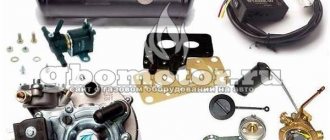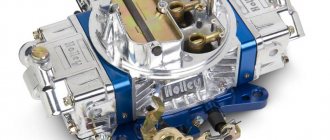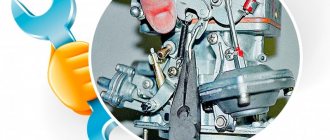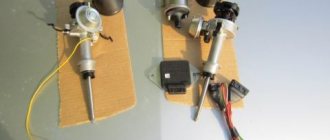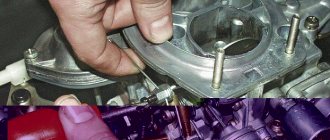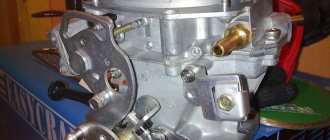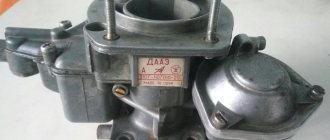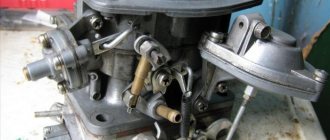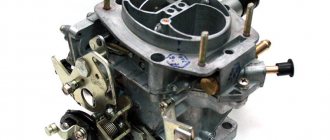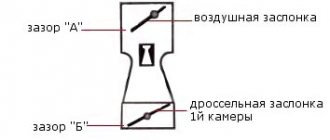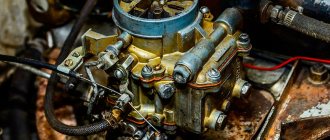The stable operation of a carburetor engine directly depends on the performance of the carburetor itself. Until recently, cars of the VAZ family were equipped with a fuel supply system using this unit. The carburetor requires periodic maintenance, which is something that almost every Zhiguli owner faces. You can do the cleaning and adjustment work yourself, just read and follow the step-by-step instructions.
- What is it for?
- Carburetor design
- Idle system
- Float chamber
- Econostat
- Acceleration pump
- Transition system
- Starting system
- What carburetors are installed on the VAZ 2106
DAAZ
- Ozone
- Solex
- Signs of a carburetor malfunction
Stalls at idle
- Dips during acceleration
Video: eliminating air leaks
- Video: fixing the stalling engine problem
- XX adjustment
Video: how to make idle stable
- Video: how to clean the carburetor
- How to remove
Video: how to remove a carburetor using the example of a VAZ 2107
Design and principle of operation
The legendary “six” - a model from the VAZ concern - was produced from 1976 to 2006. Over the entire period, more than 4 million cars of various modifications were produced. The car was equipped with engines ranging from 1.3 to 1.6 liters. Fuel type: gasoline. Both mechanical and electronic ignition were used. The fuel system had a carburetor.
How to adjust the carburetor on a VAZ 2106
They were installed from different manufacturers, but the most popular were:
- carburetors from the Dmitrov Automobile Unit Plant (DAAZ);
- Ozone carburetors. Better quality and more productive. They began to install them instead of the old ones from DAAZ. They had simpler settings and lower fuel consumption.
In addition to those presented, Solex carburetors were also installed. They were a modified version of the DAAZ, but with much better characteristics.
Any carburetor is a special device that is installed in a car to create the highest quality fuel-air mixture. This happens by mixing fuel and air in a certain proportion and supplying the finished mixture to the cylinders of an internal combustion engine. Maximum combustion efficiency of gasoline can be achieved if the mixture ratio is 14.7:1. In this case, the first number is equal to the amount of air, and the second, respectively, to the fuel. However, the presented ratio may be different, it all depends on the mode in which the power unit operates.
Carburetor "Ozone", VAZ-2106, design and adjustment
Any carburetor for a VAZ-2106 car consists of the following parts:
- float chamber;
- econostat;
- idle system;
- accelerator pump;
- launch system.
Important! Each part consists of many elements. In this regard, there are practically no fundamental differences between carburetors of different brands.
As for the adjustment, during the process it is necessary to adjust each element presented.
About service
In order for the element to work efficiently and not annoy the owner with constant failures, it must be properly maintained. Inside the unit there is a network of narrow channels. The main problem with any carburetor is that these passages or jets become clogged. As a result, the proportions of fuel and air when preparing the mixture are disrupted, and it flows poorly into the engine cylinders. The internal combustion engine operates intermittently, or even does not start at all.
Any do-it-yourself adjustment of the VAZ-2106 carburetor usually begins with maintenance activities. Thus, channels and contaminated jets are cleaned with special liquids in aerosol cans or blown out with compressed air. It is recommended to dip a very dirty carburetor in kerosene or acetone for several days. From time to time, experts recommend replacing consumables - membranes and rubber elements.
Adjustment process
The VAZ-2106 carburetor can be adjusted personally by the car owner or at a specialized station. It should be remembered that the operation of the vehicle in any driving modes, in any weather and under various conditions will depend on the quality and correctness of the procedure performed. Therefore, before starting repairs, it is important to acquire certain skills. You need to know well the structure of the carburetor and the principle of its operation. You also need to have a certain set of devices and tools:
- various screwdrivers;
- keys of various sizes;
- drills and probes (round);
- toothpicks;
- rubber bulb;
- ruler;
- tweezers;
- calipers;
- rags;
- special containers for washing.
If you have a full set of tools, you can make high-quality adjustments quite quickly.
Device adjustment devices
Adjusting the starter
The starting device is adjusted by opening or closing the air damper. This operation can be carried out directly on the car; you just need to remove the air filter. In addition, you will need:
- Unscrew the plug of the starter, since there is a special screw under it.
- Press the three-arm lever. To do this, pull out the choke lever in the cabin, then close the damper and push the rod into the body of the starter all the way.
- Using a drill with a diameter of 5.5 mm, check the size of the gap from the lower edge of the damper to the chamber wall.
- Using a thin screwdriver, turn the adjustment screw, thereby changing the clearance value.
- Next, you need to hold the air damper by the three-arm lever in the closed position and use a 1 mm drill to check the gap between the chamber wall and the throttle valve.
- Adjust the gap by installing the lever in another hole or by bending the rod.
Shifting the lever to adjust the gap
Float adjustment
This stage is one of the most important processes of general configuration. The carburetor float is an element of the so-called float chamber. If an increased amount of air or gasoline in the mixture enters the combustion chamber, the engine will run unevenly. This increases both gasoline consumption and its toxicity when there is a lot of fuel supplied. Conversely, there will not be enough fuel for normal combustion if there is little supply. The correct amount of mixture requires adjustment of the float. It is recommended to set its stroke to 8 mm.
In addition, before installing the indicator, it is advisable to remove it and check for the absence of various violations, defects and other problems.
If a car enthusiast suspects poor quality work, the float needs to be replaced altogether.
Mixture adjustment
All actions are carried out using control screws. They have a factory press-fit made of plastic, which limits their speed in the range from 50 to 70°. If the presented range is not enough, you can break off the press-on and set the required value. However, this must be done on a warm engine.
Adjusting the throttle valves
Idling
Sequencing:
- Start the engine and wait until it warms up to a normal temperature of 90 °C. After this you need to turn it off.
- Find the screws on the carburetor and tighten them completely. After that, unscrew the quality screw by five turns, and loosen the quantity screw by three.
- Start the engine and use the speed screw to set the speed on the tachometer to 800 rpm.
- Tighten the quality screw until the number of revolutions begins to drop. Periodically you should stop and add half a revolution.
Adjusting the rods
Before carrying out any actions, you need to measure the distance between the ends of the rods. This is done using a caliper. According to the original factory settings, this distance should be 80 mm. To adjust the length, you will need to loosen the clamps.
After this, you should check the filter. The shut-off valve needs to be cleaned and dried. It is responsible for loss of power and problems with the supply of gasoline, so it is recommended to thoroughly flush the entire carburetor.
As a final step for adjusting the rods, it is recommended to check the tightness of the locking needle. For this you will need a pear. If air loss is heard, the needle needs to be replaced.
Signs of trouble
Symptoms of the development of a rich mixture are:
- increased fuel consumption;
- increased engine temperature;
- loud exhausts and black smoke from the muffler pipe;
- reduction in machine power.
Signals about the arrival of a lean mixture are:
- loss of power characteristics;
- popping sounds under the hood;
- sudden heating of the engine.
Video tutorial for setting up a VAZ 2106 carburetor
All components of the car mechanism require careful care, regular maintenance and periodic preventive repairs. Prevention and maintenance consist of disassembling the housing, thoroughly cleaning and rinsing the internal and external surfaces of the parts.
After disassembling the carburetor, an external inspection of the parts is carried out and faulty components are rejected. You can start setting up only if all elements are in working order. After all defective components have been replaced and the carburetor assembly has been reassembled and installed, adjustments can begin.
Adjusting the float of the VAZ-2106 carburetor
The basis for setting up the unit is the adjustment of the float. Exceeding the standard filling level of the internal chamber leads to oversaturation of the fuel with oxygen and an increase in gasoline consumption without improving the dynamic characteristics of the car.
In terms of setting the float position, the adjustment of the 2106 carburetor is carried out in several stages:
- Removing and installing the top cover of the housing in a vertical position.
- Correction of the needle position, the result of which should be contact of the needle ball with the surface of the float.
- Control of the gap between the float and the cover, the adjusted gap should be 6 mm with a tolerance of +0.25 mm. A tool for eliminating excess or insufficient clearance is a float tongue, by pressing which the adjustment is made.
- Control of the float stroke, which in the adjusted state is 8 mm with a tolerance of +0.25 mm.
Adjusting valve clearances
The gaps are checked on a cold engine using a 0.15 mm gauge. Based on the results of the inspection, the need to refine the gaps is determined.
Ignition timing setting
The ignition timing is set by aligning the control marks on the gas distributor cover and the flywheel.
Debugging the idle speed mode
This stage of work requires preliminary preparation of the mechanisms. It is required to warm up the car's power unit to 900°C, achieve starting and stabilize the engine by rotating the qualitative and quantitative fuel screws, if this does not happen automatically.
Adjusting the VAZ carburetor at idle speed:
- By rotating the screw, which regulates the quantitative characteristics of the fuel, set the crankshaft speed in the range of 800-900 rpm;
- By rotating the screw, which is responsible for the quality of the fuel, achieve stable and smooth operation of the power unit at the maximum possible number of revolutions;
- Reduce the speed by tightening the quantity screw to speed values in the range of 950-1030 rpm;
- Increase the rotation speed again to maximum by unscrewing the quality screw;
- Consistently repeat steps 2-4 until the number 950-1030 rpm coincides with the maximum number of revolutions achieved by rotating the quality screw;
- Having achieved a coincidence of indicators, return the quality screw to the position corresponding to the number of revolutions of 800-900 rpm.
Adjusting the carburetor VAZ 2106 first stage
Unscrew the 3 nuts with an open-end wrench (10) securing the upper cover of the filter housing and remove the air filter.
Using a tubular wrench ( we will give 4 nuts from the studs securing the lower part of the body to the carburetor.
Then let's see how the air intake draft works and whether the air damper moves freely. It is possible that the bolt securing the choke cable to the bracket (the “three-arm lever” on the carburetor) will be tightened, then the damper will jam, which is not allowed.
Then, using a Phillips screwdriver, unscrew the bolt on the fuel hose clamp and pull the hose out of the tube and drain the remaining gasoline into any container.
The second stage of carburetor adjustment
We work in order:
- Using a Phillips screwdriver, unscrew the 5 screws of the top carburetor cover and remove the assembly with the float;
- Let's drain the remaining fuel and see if there is dirt there;
- Using an open-end wrench, we will stretch the 4 nuts securing the carburetor to the bottom; these nuts become loose due to constant heating;
- Unscrew the solenoid valve with your fingers (see photo below);
- Use the flat blade of a screwdriver to pull all the jets through; there is no need to completely disassemble them.
The textolite “thick” gasket presses well over time and air leaks in this place rarely occur. You should not grind the seat on the emery wheel unless absolutely necessary.
Then use a wooden toothpick to clean all the jets and holes and blow with compressed air. The jets were selected at the factory so that fuel consumption would not increase and engine power would not be reduced. Install jets according to your numbers, such as those recommended by the manufacturer. In the injection chamber, a diffuser with a larger diameter nozzle is placed with a larger hole diameter and vice versa.
The starting jet, which gives maximum power, must be put in its place, look at the photo to see how it is installed correctly.
Then we will unscrew the 2 jets in the float chamber and check the condition to see if they meet factory manufacturing standards. Carburetor repair kits contain aluminum jets instead of brass and copper, which is not recommended for car operation.
On the solenoid valve, check the presence of the rod, the condition of the rubber ring of the gasket, blow it with air and screw it back, put the positive wire “female” on the terminal “folder”. The functionality of the “finger” can be checked by connecting the positive terminal to the positive of the battery, and the body to ground; if the rod clicks, this means that the valve opens.
Then we will check the operation of the starting device, everything should work perfectly here.
We will also check the correct installation of the rod to the lever on the throttle valve axis of the first chamber.
There should be a washer on the traction lever that comes from the accelerator pedal, be sure to check, if the washer is missing, then replace it. All parts must be assembled as originally intended and repeatedly tested in practice.
Then we pump gasoline into the float chamber through the fuel hose using a gasoline pump, install the top cover with the float and, after tightening 5 bolts, start the engine. Let it run a little and, turning off the engine, unscrew 5 bolts.
Let's remove the top roof again to check the fuel level in the float chamber; the jets should be submerged in gasoline.
Disassembling the top
Let's start disassembling the carburetor before it was removed from the engine, by removing the filter mesh, unscrewing the fuel filter plug with an open-end wrench (19). We put all the parts in order so as not to lose them.
The mesh becomes clogged with fine rust from the tank, making its way through the fuel filter, it needs to be washed or replaced, taken from the repair kit.
Next, we will continue disassembling the idle speed sensor. Having unscrewed it with an open-end wrench (12), we will look at the condition of the jet with number 50 and the movable needle under it. We will also check the operation of the sensor itself by connecting the housing to the minus terminal of the battery and the wiring to the positive terminal. When closing, the sensor “clicks” if it is in working condition.
Then we release the spring on the damper rod, as well as the “yellow” telescopic spring, pressing it inward, and disconnect it from the mount.
Unscrew the 5 screws with a Phillips screwdriver and remove the top cover.
We use a hammer to knock out the float mounting stop with a thin wrench and pull out the float along with the needle. If the valve needle is worn out, replace it from the kit and also change the paper gasket.
Then use a screwdriver to unscrew the 2 screws of the starting device and examine the condition of the rubber gasket.
On the back side of the stud, from the mounting of the air filter housing, so that it does not rotate in one place, you can lock it with an additional nut. Wash the upper half of the body with kerosene using a toothbrush and rags.
Dismantling the middle part
Before dismantling the middle part, wash the float chamber with a washing liquid, for example, acetone and wipe with a dry cloth.
Let's look at it in order:
- Then use the flat blade of a screwdriver to unscrew the “nozzle” of the accelerator pump;
- We clean the thin hole of the nozzle with fishing line and blow it with a pump;
- Reassemble the nozzle in reverse order with 2 copper sealing washers and set it aside;
- Remove the small retaining ring securing the throttle valve pneumatic drive rod.
- Use a Phillips screwdriver to remove 2 screws securing the throttle valve pneumatic actuator to the middle body and examine the condition of the gasket; if the gasket is “stuck,” we will replace it;
- Using a Phillips screwdriver, unscrew the 2 screws securing the throttle body;
- Using a Phillips screwdriver, unscrew the bolt of the air damper drive rod;
- Let's separate the middle part of the case from the bottom, placing all its parts carefully to the side;
- Separate the thick textolite gasket that holds the 2 paper gaskets;
- Unscrew the 4 bolts of the accelerator pump cover and set aside the diaphragm with the spring;
- Unscrew 2 air supply jets with both hole diameters (150);
- Using a wooden pencil, draw out 2 cylinders of air jets with many holes for air supply and blow them out with a pump;
- Let's give fuel nozzles in the float bath, one with a hole diameter (112) from the small injection chamber and another (150) from the large one;
- Unscrew the accelerator pump fuel supply adjusting screw;
- Unscrew the adjusting screw for the composition of the “quality” of the idle mixture;
- We pull out the diffusers of the fuel mixture injection chambers with pliers.
Diffusers are placed with the holes facing the holes, and clamps with a rigid spring are placed on the back side towards the wall. Diffusers differ in numbers (35) for the primary chamber with a smaller diameter, and for the secondary chamber (45) with a larger diameter.
If it’s difficult to figure it out, contact carburetor specialists...
You need to disassemble all the parts to wash them well and reassemble them in reverse order.
Working with the bottom
It remains to work with the lower part. Using a Phillips screwdriver, unscrew the 2 bolts that hold the body of the idle mixture adjustment screw with the restrictor sleeve. Let's check its sealing gasket and, if necessary, replace it. Let's unscrew the needle valve and check the condition of the rubber ring and, if there is a lot of wear, replace it.
Everything has been disassembled down to the screw, all that remains is to wash it with a special carburetor cleaner or acetone and reassemble it in the reverse order.
There is nothing complicated in this work, everything will shine on the outside, as well as on the inside.
The third stage of carburetor adjustment
Then use a Phillips screwdriver to finally tighten the top carburetor cover with five bolts, not too tightly, but not too loosely, so that the cover does not hang loose and the threads are not stripped. Install the fuel hose and tighten it with a clamp.
Pay attention to the drainage tube of the INTAKE manifold, whether it is in its place, air is sucked through it in a dosed manner.
The tube is correctly installed in the letter “G” so that gasoline does not get into the EXHAUST manifold...
On the new VAZ 2107 “OZON” carburetors (DAAZ 2107-1107010-20) there is no drain tube on the intake manifold.
Then we start the engine to check proper operation. Use a screwdriver to adjust the idle speed and starting system; this adjustment should be done 1-2 times a year.
How to install the unit in place
You can assemble and reinstall the carburetor in the same way as you disassembled it, performing all the steps in reverse order.
- The carburetor is installed in its place, the mounting bolts are tightened.
- The pipes through which fuel is supplied are attached. The gas cable is connected to the throttle lever.
- The wiring is attached.
- A vacuum hose is connected to the ignition distributor, and the EPHH limit switches are combined.
- After installing the carburetor, it is adjusted.
Video: installing a carburetor on a VAZ
It is not so difficult to independently remove, disassemble, clean and reinstall the carburetor in the VAZ 2107 and 2106. The main thing is not to be intimidated by the huge number of hoses, valves, parts and dirt and strictly follow the instructions.
Didn't find the information you are looking for? on our forum.
We recommend reading:
Is it possible to fill Priora with 92 gasoline, manufacturer’s recommendations
The oil pressure light on a VAZ 2114 does not come on when the ignition is on, how to repair it
How to remove the radiator on a VAZ 2115 - 2114
No spark on VAZ 09 carburetor
Pinout of the crankshaft sensor VAZ 2110
The car jerks when starting the VAZ 2114, several main reasons
Cooling system VAZ Kalina 8 valves
Adjusting the rear axle gearbox of a VAZ 2106 at home
The final stage of carburetor adjustment
If the threads on the 4 studs securing the air filter housing are broken, you need to replace them with repair ones and tighten them, dripping a little special liquid fixative onto the threads.
We place the lower filter housing and fasten it with 4 HIGH by 7 mm nuts with nylon so that it does not get sucked into the cylinders if it spins spontaneously due to engine vibration.
Important point! If you find that the nuts are 3 mm low, be sure to buy high 7 mm self-locking nuts from the auto store and install them yourself...
In winter, you cannot operate the car without a corrugation to heat the air supplied to the filter from the exhaust manifold.
Breather pipe Niva VAZ 2106-07 (2121-1014056).
And also, according to environmental laws, you cannot drive without a rubber hose of the engine breather; the most harmful gases come out from there, which you breathe. Don't poison yourself and your family.
It is important to know! The engine will not jerk or jerk when the spark plugs are in working condition. It is advisable to change one contact spark plug every 25,000-30,000 kilometers.
Don’t neglect to replace consumable parts on time and you won’t pay twice...
Computer diagnostics shows errors and deletes them, shows parameters, adapts. In case of complex failure, a motor tester, a gas analyzer, a smoke generator, a compressometer, an endoscope and other instruments and devices are used.
↑ Checking and repairing carburetor body parts
We wash the jets, emulsion tubes and other removed parts, except gaskets, in acetone and blow them with compressed air.
We use a ruler to check the base of the body for curvature.
The base must be flat. If a curvature of the plane is detected, we remove the adapter tubes, for which we select drills with a slightly smaller diameter than their holes. Insert the drill into the tube. To make it fit tightly, you can wrap fine-grained sandpaper around it.
Use pliers to remove the tubes.
Straightening the carburetor body
If the deformation is small (the gap is no more than a millimeter), we level the base by squeezing the body in the jaws of a powerful vice. To avoid damaging the top surface of the carburetor, place a sheet of plywood or a wooden block under the jaws.
We first straighten a heavily deformed surface by lightly hitting the curved corners of the base with a wooden mallet. This must be done carefully, as you can easily break off a piece from the body. After rough straightening, use a wide velvet file to level the surface. At the same time, we hold the file parallel to the plane of the base, without “piling over” at the edges. We constantly monitor the process by applying a ruler to the surface.
Read with this
- Shoots the carburetor
- Carburetor for 126k and its modifications
- Do-it-yourself valve adjustment on a VAZ 2107 with an injector
- Adjusting the sorcerer VAZ 2114: subtleties of the process
- What is an oil pump and what is it for?
- About the idle speed regulator VAZ 2107 (injector)
- How to quickly remove the starter on a VAZ 2110 with your own hands
- How to change the gas tank on a VAZ 2110 yourself
- Where is the wiper relay for VAZ 2107?
- How to change the fuel pump? step by step instructions
Adjusting the idle speed on Ozone carburetors
Before you begin adjustment work, you should warm up the internal combustion engine to operating temperature; it is also important that the carburetor is clean, without clogged channels. Next we proceed as follows:
- start the engine at idle speed (XX);
- using the quantity screw, unscrewing it, we increase the speed by 100 more than the normal norm;
- we begin to tighten the quality screw until the engine begins to work less steadily, then we turn it back a little, achieving stable operation;
- we find the optimal operating mode of the motor at idle with the quality screw tightened as much as possible, while 850 rpm is considered the norm (from 800 to 1000 is allowed).
With proper adjustment, gasoline consumption in urban areas averages 8.5-9.5 l/100 km, but the engine must be in good working order and the ignition must be set correctly. Even on Ozone carburetors, the solenoid valve jet often becomes clogged; before adjusting the idle mixture, it should be checked and, if necessary, cleaned.
How do you know if the carburetor needs adjustment?
If the fuel mixture is excessively enriched with oxygen, the engine will either start poorly or refuse to start at all. Inexperienced motorists at this moment, trying to start the engine again and again, fill the candles. If the mixture is too lean, the engine will run unstably, but the power will also be significantly reduced.
Adjusting the OZONE VAZ-2106 carburetor is necessary if there are difficulties in starting a cold engine. It is also worth doing the tuning if you feel unstable operation of the internal combustion engine at idle, if when you press the gas there are dips in transition or any other modes. Popping noises from the muffler are also an indicator for adjustment.
It is possible to adjust the idle carburetor of the VAZ-2106 and the fuel level in the float chamber. Nothing else can be adjusted. Dynamics and flow are regulated by changing jets.
Do-it-yourself carburetor adjustment on a VAZ
Before adjusting the VAZ-2106 carburetor or its equivalent, you should perform the following operations:
- Check the timing valve clearances for correctness:
- eliminate malfunctions of the ignition system, if any;
- clean or replace spark plugs if necessary:
- clean the carburetor;
- adjust the position of the float valve.
Carburetor adjustments are made with the engine preheated. First, with the engine not running, both adjusting screws must be tightened until they stop. After this, unscrew the screw that regulates the amount of fuel mixture three turns. Then we unscrew the screw that regulates the fuel quality by 4-5 turns.
To make further adjustments, start the engine. By rotating the fuel quantity adjustment screw, we set the speed within 800 rpm. After this, using the screw that ensures quality, we lean the air-fuel mixture (to do this you need to tighten it) until the speed begins to drop. In this position, fix this screw, and then unscrew it in the opposite direction by 1-0.5 turns, achieving stable operation of the engine in idling mode. It is recommended to revoke the engine and make sure that the engine speed in idle mode is within 800 ±50 rpm.
Setting up the float chamber
An incorrectly set gasoline level in the float chamber can cause difficulty starting the engine and subsequent unstable operation. The level should be along the line of transition of the inclined wall to the vertical one. The reader can see a photo of adjusting the VAZ-2106 carburetor with his own hands in our article.
The carburetor cover is placed vertically, with the gasoline supply fitting facing upward. When the tongue touches the needle valve, measure the distance from the gasket to the float. It should be within 6.5 millimeters. If the distance is greater or less, bend the tongue to achieve the required distance. There should be no deviations in one direction or another.
Nuances and main malfunctions of Solex carburetors
Despite all the positive aspects and advantages, Solex carburetors have their disadvantages and characteristic “diseases”; one of the main disadvantages is problems with idling due to clogging or airing of the channel. Air enters the XX system mainly due to the tight fit of the cover to the body, since over time the metal is deformed, and such a defect can be corrected by replacing the gasket and grinding the adjacent surfaces.
Another common problem with idle speed is a clogged channel, which can only be cleared if you remove the quality adjustment screw. But the whole difficulty lies in dismantling this screw, since it is located deep in the “body” of the carburetor and is held in place by a rubber seal.
Even a completely unscrewed screw does not simply come out of the channel; it can be dismantled using a piece of hollow tube, for example, taken from an old radio. To use the tube as a puller, we make two cuts at the end, then insert the device into the channel, and remove the part we need by twisting it out.
Another typical drawback of Solexes is failure while driving when accelerating the car, which occurs due to the accelerator pump. To correct this defect, car owners most often upgrade the accelerator pump nozzle (“spout” or “elephant” in common parlance), transferring the injection of both tubes to the primary chamber. Solex practically does not cause any other troubles; it serves for a long time and reliably.
The work applies exclusively to the idle speed of the VAZ 2106. The setting does not affect other engine operating modes. There are two screws for regulation: a large one for the number of revolutions and a small one for the quality of the mixture.
Before starting work, make sure that the ignition system is working properly. Adjust or repair it if necessary. The engine must also be in good working order.
Troubleshooting other problems
Among minor problems, the most common problems are idle speed. They are decided depending on the reason:
- The electric valve that opens the idle jet does not work. Check the voltage supply to it with the ignition on, and then unscrew the valve and watch how it retracts the needle. If this does not happen, replace the part.
- The idle jet is clogged. Again, unscrew the valve and blow through the calibrated hole.
- The rubber o-ring on the valve has become loose. As a result, air leaks occur, causing the engine to operate unstably. Replace the seal.
- The rubber ring sealing the idle channel is torn or weakened. It is put on a thin brass tube pressed into the carburetor body. To get to it, you need to remove the unit cover.
- The channels supplying the fuel mixture for idling are clogged. The issue is resolved by washing and purging, as described in the previous section.
Idle valve with jet
Replacing the trigger diaphragm
When the car stalls during a cold start, you need to change the trigger diaphragm. Due to the breakthrough, it does not retract the air damper, causing the engine to “suffocate.” The unit is located on the right side (in the direction of travel), its square cover is held on by 4 screws. Unscrew them and change the diaphragm.
Replacing the accelerator pump diaphragm
When you feel a “failure” when you press the accelerator and accelerate the car, your actions should be as follows:
- Check the accelerator pump diaphragm, located under the cover on the left wall of the carburetor (in the direction of travel of the car). If it is torn, replace it.
- Remove the air filter housing and the top cover of the Solex. Underneath it, look for nozzles built into the fuel supply diffusers. Pry them off with a screwdriver, pull them out and blow them out. Replace the rubber ring if it is torn.
- Test how well the accelerator pump lever presses the diaphragm. If play is detected, change this lever.
The nozzles are removed using a screwdriver
The last malfunction lies in the electronic unit EPHH, which controls the operation of the electric valve. If the “eight” stalls when coasting in gear, then the reason is precisely this block. Changing it is not a problem; the price of this part is low.
Replacing the EPHH block
As a rule, after eliminating the listed problems, carburetor adjustment is not required. But if you notice a change in speed in one direction or another, then the settings can be slightly adjusted.
Which carburetor model to choose
For any VAZ car, starting from 2101 to 2107, only certain carburetor models are suitable.
DAAZ carburetors
Carburetors DAAZ 2101, 2103, 2106. They were produced at the Dmitrov Automotive Unit Plant, which bought a license from the Italian company Weber, therefore these carburetors can be indicated under both names. The devices were not distinguished by the complexity of their design, but they could please their owners with the rapid acceleration of the car and good speed. One of the biggest problems in installing these models is their virtual absence on the market.
In addition to speed and simplicity, Weber carburetors also provided incredibly fast fuel consumption - these “monsters” consumed 10–14 liters per 100 km. fuel.
The powerful but resource-intensive Weber carburetor was produced by the Russian Dmitrov plant using Italian technology
Carburetors "Ozone"
More technologically advanced models, which were already installed in VAZ 2105 and 2107 cars, were also produced at the Dmitrov Automobile Unit Plant. However, they were not only more advanced and improved, but also more environmentally friendly. This is why they received the name “Ozone”. This carburetor made it possible to reduce fuel consumption to 7–10 liters. 100 km, while maintaining the dynamic characteristics of its predecessors. The downside of the device was the complexity of its assembly and constant contamination in one of the chambers, which led to the fact that the acceleration of the car noticeably deteriorated, the speed decreased and the engine began to act up.
“Ozone” is an environmentally friendly model of DAAZ carburetors
Solex
A little later, DAAZ 21053 carburetors appeared. They were produced under license from the French company Solex, hence the name of the models. These carburetors were not much similar to previous DAAZ models. The updated design with a fuel return system made it possible to save 400–500 ml of fuel per 100 km. These carburetors were distinguished by good power and low gasoline consumption. The disadvantage of the device was the narrow fuel and air channels, which very often became clogged.
The Solex carburetor successfully combines the power and environmental friendliness of its predecessors
Solex carburetors came in many variations with different auxiliary systems. In the CIS, the most popular option has become an electric idle air valve.
Custom carburetor Solex 21073
Often, inquisitive car enthusiasts resorted to replacing the carburetor on their own. One of the suitable models turned out to be Solex 21073, famous for its fairly wide jets and channels. Such a carburetor increased the car’s power, but at the same time increased fuel consumption - 9–12 liters. per 100 km.
Solex 21083
The second non-standard carburetor, which with some modifications fits the VAZ 2106 and 2107 models, is Solex 21083. After expanding the diffusers and installing jets, this device allows you to significantly increase the dynamics of the car without much fuel consumption. However, the process of upgrading a carburetor is very complex and time-consuming.
Design of DAAZ units
Detail on a car
A standard carburetor consists of the following parts:
- mechanism for maintaining a constant fuel level;
- engine starting and warming up system;
- idle system and transition system of the second chamber;
- accelerator pump;
- main dosing system;
- econostat system.
Large and small carburetor diffusers have some differences: a small diffuser marked 3.5 goes to the primary chamber, and 4.5 goes to the secondary chamber. The original diffuser has a membrane inside, which is designed to better separate the mixture. It must be remembered that drops of fuel will always collect on the exhaust channel membrane.
The difference in diffusers lies in the difference in pressure distribution: if the diffuser is smaller, then good vacuum near the atomizer itself is achieved at low speeds, and if it is larger, then mixture formation is achieved at higher speeds. This means you can install 3.5 marked parts to keep the sprayer running at low speed. This solution will be especially relevant for small-volume engines.
The production of carburetors such as DAAZ 2105 and DAAZ 2107, sometimes called “Ozone,” was mastered in 1979, when the Soviet automobile industry began producing the famous VAZ-2105. Although the VAZ 2105 is not currently in production, carburetors for these models continue to be produced, and their use is still relevant. The DAAZ 2105 carburetor model was produced for engines with a displacement of 1300 cc. cm, and model type 2107 is for 1500 cc engines. cm. They differed in the diameter of the mixing chambers and the size of the nozzle holes.
Differences between the 2105 carburetor model and previous families.
- Autonomous idle system with double emulsion.
- Availability of forced idle economizer.
- There is a pneumatic drive for the throttle valve of the secondary chamber.
- Vacuum operation.
- Availability of automatic engine start and warm-up.
Reasons for adjusting the VAZ 2106 carburetor
If the mixture coming from the carburetor to the engine is too rich in fuel, it can flood the spark plugs. If the mixture is too lean, engine power will noticeably decrease. The main symptoms of suboptimal mixture composition are:
- difficulty starting a cold engine;
- unstable engine operation at idle;
- dips when pressing the accelerator pedal;
- loud pops from the muffler.
In most cases, the problem can be solved by timely adjustment of the mixture composition using quality and quantity screws. By rotating these screws, you can change the clearance of the emulsion channels, the fuel level in the float chamber and provide additional fuel to compensate for the excess air. This procedure will only take a few minutes.
The car won't start
The cause of difficulties when starting a cold engine, when the crankshaft rotates but the engine does not start, may be the ignition system and carburetor. If the ignition is working properly, most likely the nozzles, strainer or other elements are clogged, making it difficult to supply fuel to the float chamber. You can fix this problem as follows.
- It is necessary to clean clogged channels and jets with a special aerosol carburetor cleaner, and then blow them out with a stream of compressed air. Using aerosols to flush the carburetor will eliminate the need for dismantling it.
- If there is no fuel in the float chamber, the strainer and needle valve should be flushed. To do this, the filter will need to be removed from the carburetor.
Flushing the fuel filter eliminates the possibility of oil deposits preventing fuel from penetrating into the float chamber. - It is necessary to check the presence of gasoline in the float chamber using the accelerator pump (AP). When you sharply press the accelerator lever, you should be able to see fuel being thrown into the mixing chamber from the nozzle channel.
When the throttle valve is pressed, the lever through the drive sector acts on the diaphragm pusher, and fuel is instantly injected through the nozzle into the diffuser.
Car stalls at idle
In idle mode the valves are closed. A vacuum is formed under them, ensuring the flow of fuel through the hole under the damper of the first chamber. The cause of a situation in which the engine starts but runs unstably is most often the carburetor. Depressurization of its housing may occur. This will lead to excess air entering the carburetor, leaning the fuel-air mixture. The settings of the quality and quantity screws that regulate the composition and quantity of the combustible mixture may also fail. In addition, the lack or absence of fuel in the float chamber leads to a lean mixture entering the engine.
The current situation will require the car owner to perform the following actions.
- To eliminate depressurization of the housing, replace the sealing gaskets between its individual parts.
The Ozone carburetor uses a heat-insulating gasket as a sealing element - Tighten all bolted connections.
During operation, to prevent depressurization, the screw connections of the carburetor parts should be periodically tightened. - To prevent depressurization, replace the rubber ring of the solenoid valve and quality screw.
- Check the condition of the ignition timing vacuum regulator hose for wear and mechanical damage.
A loose connection in the vacuum ignition timing regulator hose allows excess air to enter the carburetor. - Set the optimal gasoline level (in the Ozone carburetor it is located in the middle of the inclined wall of the float chamber) by bending the float mounting tab. The float gap (distance between the float and the gasket adjacent to the carburetor cover) should be 6.5 ± 0.25 mm.
The optimal fuel level is in the middle of the inclined wall of the float chamber - Use the quality screw to adjust the free movement of the fuel emulsion through the idle system, and use the quantity screw to adjust the volume of the mixture supplied to the cylinders.
Rotation of the quality screw changes the size of the fuel channel, reducing or increasing the flow of fuel emulsion
The smell of gasoline appears in the cabin
In any case, the appearance of a fuel smell in the cabin is due to its excess in the float chamber or a loose connection of the housing elements as a result of wear or mechanical damage to the sealing gaskets and rubber hoses.
The appearance of a smell in the interior of a VAZ 2106 is a sign of a high fire hazard. In this situation, you should immediately turn off the engine and take all measures aimed at identifying the malfunction. Starting the VAZ 2106 is possible only after eliminating the causes that led to the penetration of gasoline vapors into the vehicle interior.
To eliminate the causes of gasoline vapor entering the cabin, you should:
- Check fuel lines for leaks.
- Replace the carburetor sealing elements.
Periodic replacement of sealing elements to eliminate malfunctions in the carburetor during long-term operation - Measure with a caliper and set the optimal height of the float position, ensuring complete shutoff of the needle valve (6.5 ± 0.25 mm). The location of the float in the chamber must ensure complete closure of the needle valve
Dips when pressing the accelerator pedal
When you press the accelerator pedal, the throttle valve opens. Next, the accelerator pump comes into operation through an articulated lever. If it is faulty, then pressing the pedal will lead to interruptions and engine stop. This most often manifests itself when starting from a stop and suddenly accelerating. When you sharply press the accelerator lever, a powerful jet of fuel should be observed from the nozzle channel into the emulsion chamber. A weak stream may be due to:
- clogging of supply channels, spray nozzle and discharge valve;
- depressurization of the housing;
- a broken tube of the vacuum ignition timing regulator.
To resolve this problem you must:
- Replace the carburetor sealing elements.
- Tighten bolted connections.
- Replace the rubber o-ring of the solenoid valve.
- Check the vacuum ignition timing regulator tube for wear and mechanical damage.
- Repair the accelerator pump (rinse the supply channels, clean the spray nozzle of deposits, replace the diaphragm).
The causes of interruptions when pressing the accelerator pedal are often faulty elements of the accelerator pump.
Video: repair and maintenance of the VAZ 2106 accelerator pump
Popping sounds in the exhaust system
The appearance of loud sounds in the exhaust system is a consequence of the fuel-air mixture being too rich. Such a mixture with a high content of the liquid phase, without having time to burn out in the working cylinders and having heated up to maximum temperatures, ends the cycle with an explosion in the exhaust system. As a result, loud popping sounds are heard from the muffler. In addition to the carburetor creating a mixture with an excessively high concentration of fuel, the reasons for this situation may be:
- late ignition;
- loose fit of exhaust valves;
- mismatch of valve timing.
To eliminate possible causes of this malfunction, you must:
- Remove the valve cover, measure the thermal clearance of the exhaust valves and adjust it if necessary.
A correctly set thermal clearance of the exhaust valves prevents the valves from being pinched and the unburned mixture being thrown into the muffler. - Adjust the fuel supply to the carburetor by setting the required clearance of the shut-off valve in the float chamber. The distance from the float to the carburetor cover with gasket should be 6.5 ± 0.25 mm.
Correctly set float clearance ensures optimal fuel level in the chamber - By rotating the quality screw and thereby changing the cross-section of the fuel channel, achieve free movement of the fuel emulsion along the idle circuit. Use the quantity screw to adjust the volume of mixture supplied to the cylinders.
The composition and quantity of the mixture coming from the carburetor is regulated by quality and quantity screws: 1 - quality screw; 2 - quantity screw - Set the ignition timing. To eliminate the possibility of late ignition, loosen the octane corrector mounting nut and turn the housing 0.5 scale divisions counterclockwise.
The ignition of the mixture is greatly influenced by the correctly set ignition timing: 1 - housing; 2 - scale; 3 — nut for fastening the octane corrector
How to adjust Solex DAAZ 2108–1107–10
It is advisable to start the process of setting up and adjusting the performance of the carburetor mechanism from the float compartment. This is due to the fact that there is fuel here, the level of which must be strictly fixed. If the gasoline level is below or above normal, then adjusting other components becomes pointless.
Float adjustment
The adjustment procedure includes several steps:
- First start the engine and let it run for 3 minutes, then turn it off.
- Remove the air filter box and put it aside, as it prevents free access to the carburetor.
- The first step is to disconnect the pipe through which gasoline is supplied from the Solex body.
- Use a flathead screwdriver to unscrew the five screws on the cover to remove it.
- Measure the distance from the edge of the float chamber to the fuel level. It should be equal to 25.5 mm. If there are differences, you will need to set the desired parameter by bending the float bracket.
- You will also need to set the axis of the float so that it can move freely.
- The adjustment of the float chamber and float is now considered complete.
Adjusting the starter
You can adjust the carburetor on the VAZ 2108 and 2109, as well as repair it yourself. This work should be performed on the carburetor, which has been removed from the engine and installed on a flat surface. If the trigger diaphragm was damaged, then it is necessary to initially replace it and only then begin adjustment work:
- Turn the air damper adjustment lever and close it completely.
- Lower the trigger rod with the blade of a screwdriver and hold it in this position.
- Measure the width of the gap between the damper and the chamber wall. The existing indicator should be 1 mm. If this is not the case, then adjustments will be required.
- You will need to loosen the lock nut, which is located on the surface of the accelerator pump, and at the same time turn the quality screw with a screwdriver. If you turn the screw in one direction, the gap will increase, and if you turn it in the other direction, it will decrease.
- Measure the gap thickness again.
- The air damper on the second chamber is adjusted using the same principle.
You can measure the gap width using a drill with a diameter of 1 mm
How to adjust idle speed
This procedure can only be carried out on a carburetor installed in the car, after the engine has warmed up well. In this case, the air filter will no longer impede access, so it remains in its place under the hood:
- Turn off the engine.
- Tighten the air-fuel mixture quality screw all the way, and then unscrew it no more than four turns.
- Start the engine again, simultaneously turn on all the lighting, acoustics and heater to increase energy consumption.
- Working with the quantity screw, you need to set the number of revolutions of the running motor to 750–800 per minute.
- The quality screw sets the maximum idle speed - 900 rpm (in winter, this parameter can be increased to 1000 rpm).
- After this, you will need to tighten the quality screw back until interruptions in engine operation are felt. At this moment you will need to stop and make one revolution back.
Adjusting the idle speed on the VAZ 2108/2109 is necessary to ensure that the car exhibits stable operation in the set mode without high consumption of the air-fuel mixture.
If not the valve, then what?
Dirt, low-quality fuel, malfunction of the ignition system - all this separately and in the compartment can affect the idle speed disappearing or becoming unstable. If you have already decided to carry out a full diagnosis, then start with the filters - air and fuel.
If they are heavily clogged, then gasoline or air (these are the main components of the air-fuel mixture) will not enter the carburetor normally. To be more precise, they will hit, but only after overcoming great resistance. And don't forget about the thimble-shaped filter that is installed at the inlet of the carburetor.
When is adjustment needed?
Adjusting the carburetor unit is no more difficult than adjusting the clutch drive on a VAZ 2107, since it only involves adjusting the jets. In some cases, they need to be cleaned of resins and other contaminants; the presence of contaminants is felt by power dips in the process of accelerating. Many car owners claim that Ozone carburetors are not a very good option and recommend replacing them with Solex.
However, the signs that the device has begun to prepare an enriched mixture and needs to be adjusted are the same for both types of units:
- Increased fuel consumption.
- Frequent overheating of the motor.
- Black smoke from the exhaust pipe and pops.
- Loss of power.
The preparation of a lean mixture is characterized by the following characteristics:
- Popping sounds in the carburetor.
- Loss of power.
- Engine overheating.
Of course, you don’t always need to immediately grab a screwdriver and turn the adjusting screws - perhaps it’s something else. For example, when the idle speed floats, air may leak through the intake manifold gasket, or there may be a breakdown of the brake booster diaphragm. But even the reasons listed are not all the options, so specific recipes for eliminating certain problems cannot be given. The issue should be addressed comprehensively, taking into account the connection between vehicle systems.
What do we have after proper adjustment of the carburetor unit of the “six”?
Checking the adjustments of the fuel mixture preparation unit is the same important maintenance step as monitoring the condition of the car battery. An integrated approach to setting up the carburetor guarantees not only a comfortable mode of movement, but also a lot of useful points:
- An increase in power and a confident increase in speed.
- No failures in the operation of the internal combustion engine in the low and medium speed sector.
- Improved dynamic characteristics - the car picks up speed faster and accelerates in a short time.
- Optimal engine response, which is expressed in the responsiveness of the gas pedal.
The listed qualities make it possible to effectively use the combustible mixture, which is necessary both in urban traffic jams and on country roads. Therefore, proper adjustment of the carburetor unit will help the car gain speed in a timely manner and complete the planned maneuver.

